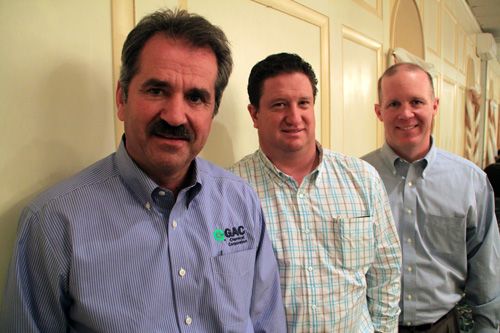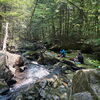Processing Your Payment
Please do not leave this page until complete. This can take a few moments.
- News
-
Editions
View Digital Editions
Biweekly Issues
- December 1, 2025
- Nov. 17, 2025
- November 03, 2025
- October 20, 2025
- October 6, 2025
- September 22, 2025
- + More
Special Editions
- Lists
- Viewpoints
-
Our Events
Event Info
Award Honorees
- Calendar
- Biz Marketplace
Proximity to Maine paper mills lures Mexican co.
 Photo / Darren Fishell
From left, John Wolanski, vice president of sales and marketing for GAC Chemical; Manuel Rivadeneyra Díaz, president of Dalegip America Inc.; and David Colter, president and COO of GAC Chemical.
Photo / Darren Fishell
From left, John Wolanski, vice president of sales and marketing for GAC Chemical; Manuel Rivadeneyra Díaz, president of Dalegip America Inc.; and David Colter, president and COO of GAC Chemical.
A Mexican chemical company is banking on sales to Maine's coated paper producers in its new partnership with the Searsport-based GAC Chemical.
Dalegip America Inc., which makes industrial pigment products, has entered into a contract with GAC to make pigments for U.S. markets. Manuel Rivadeneyra Díaz, president of Dalegip, says penetrating American markets has been impractical from the company's Mexican headquarters, just north of Mexico City.
"We tried to sell products directly from Mexico to the United States," Díaz says, but the delivery time and transportation costs for the hollow sphere plastic pigment products were not competitive. The specialty pigments are about 70% water.
"On one visit [years ago] to one of the biggest [paper] producers, the sourcing fellow asked us if we would consider doing something in Maine," Díaz says. "Some years later, we decided to come here to Maine and the reason is basically the paper industry."
Díaz declined to say which paper mill enticed his company to come to Maine, but he and GAC Chemical President and COO David Colter said Sappi, Verso and NewPage are among the mills they want as clients.
In Mexico, Díaz says, most of the company's customers produce packaging, not paper. The company, which employs 120, was founded by his father in the state of Querétaro. It had already netted a large market share in Mexico and was seeking new markets -- an added reason for expanding to Maine. Partnering with GAC, rather than going it alone, will help expedite the expansion, he says.
Díaz was in Maine last week to continue planning the company's operations in Searsport. GAC, which has around 70 employees, plans to hire about 12 people to run the new product line.
In the short term, GAC will add one new chemical reactor at its Searsport facility by the end of this year, but Díaz says there are plans for two if demand warrants it. Beyond that, GAC's Colter says there's still more room to expand.
"We own 153 acres right on the bay and we're only using about 40 acres," Colter says, "so there's plenty of room for expansion."
John Wolanski, GAC's vice president of marketing and sales, says the market might extend beyond Maine mills.
"Because it is a specialty [chemical], we've already had interest in shipping the product as far away as Minnesota," Wolanski says. "So, just because the product is made in Maine doesn't mean it's limited to just Maine or New England."
John Williams, president of the Maine Pulp and Paper Association, says GAC and Dalegip's new venture will be a good bet if it can cut papermaking costs.
"If our companies can get these [pigments] at a lower cost, that's an advantage to them and it has environmental advantages, too," Williams says.
Wolanski says shortening the supply chain by producing pigment in Maine could reduce the carbon footprint of pigment delivery by up to 90%. That reduction could be a significant benefit to Maine coated paper producers because large customers like Time Inc., the largest magazine company in the United States, have begun to use sustainability metrics in choosing suppliers.
The supply chain cut also holds savings on transportation costs, which Wolanski says can add between 25% to 40% to the delivered costs of pigments.
In moving production to Maine, Dalegip also plans to offer just-in-time delivery to Maine mills, which Wolanski says could cut down on inventory costs and reduce delays for paper producers. That's a significant improvement over the 34-day delivery time Díaz says is typical for shipping across the border.
Dalegip and GAC haven't inked any contracts with Maine paper companies, but they say it's still early in the process. It will take six months of construction to expand chemical mixing capacity to GAC's Searsport facility. The companies hope to begin producing up to 1,500 metric tons of Dalegip pigment by the end of 2014.
"We view this as just the beginning of a long-term investment," Wolanski says.
Read more
Mainebiz web partners

The Giving Guide
The Giving Guide helps nonprofits have the opportunity to showcase and differentiate their organizations so that businesses better understand how they can contribute to a nonprofit’s mission and work.
Learn More
Work for ME
Work for ME is a workforce development tool to help Maine’s employers target Maine’s emerging workforce. Work for ME highlights each industry, its impact on Maine’s economy, the jobs available to entry-level workers, the training and education needed to get a career started.
Learn More
Groundbreaking Maine
Whether you’re a developer, financer, architect, or industry enthusiast, Groundbreaking Maine is crafted to be your go-to source for valuable insights in Maine’s real estate and construction community.
Learn more-
The Giving Guide
The Giving Guide helps nonprofits have the opportunity to showcase and differentiate their organizations so that businesses better understand how they can contribute to a nonprofit’s mission and work.
-
Work for ME
Work for ME is a workforce development tool to help Maine’s employers target Maine’s emerging workforce. Work for ME highlights each industry, its impact on Maine’s economy, the jobs available to entry-level workers, the training and education needed to get a career started.
-
Groundbreaking Maine
Whether you’re a developer, financer, architect, or industry enthusiast, Groundbreaking Maine is crafted to be your go-to source for valuable insights in Maine’s real estate and construction community.
ABOUT
NEW ENGLAND BUSINESS MEDIA SITES
No articles left
Get access now
In order to use this feature, we need some information from you. You can also login or register for a free account.
By clicking submit you are agreeing to our cookie usage and Privacy Policy
Already have an account? Login
Already have an account? Login
Want to create an account? Register
Get access now
In order to use this feature, we need some information from you. You can also login or register for a free account.
By clicking submit you are agreeing to our cookie usage and Privacy Policy
Already have an account? Login
Already have an account? Login
Want to create an account? Register







Comments